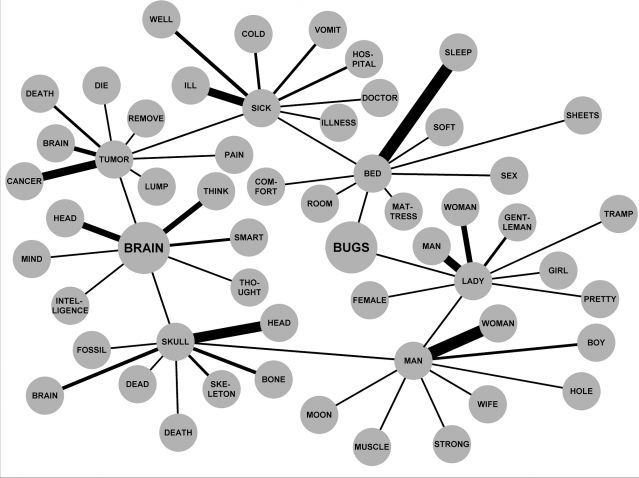
Memory
What Do Cows Drink? (The Associative Architecture of Human Memory)
The causes of the features and bugs of human memory.
Posted July 22, 2012
The brain has an irrepressible ability to make associations. This is well illustrated by one of my favorite illusions, the McGurk Effect, which demonstrates that what we “hear” is strongly influenced by what we see.Throughout your life every time you witnessed someone say baby or baklava you saw their lips come together then separate to pronounce the syllable “ba." Even though you’ve probably never consciously thought about this fact, your brain uses it to decide what you are hearing. The result is the McGurk effect: we will often “hear” the syllable “da” if the visual track of a video shows someone saying “ga” even if the sound is “ba."
The Memory Web
It is difficult to overstate how much our mental faculties rely on the brain’s ability to create links between the sounds, sights, concepts, and feelings it experiences. For example, it is through auditory and visual associations that children learn to make sense of the world. You know the word cat refers to a cute, snobbish, four-legged creature because Mom insisted on saying “look at the kitty cat” the first thirty-seven times you saw a cat. Indeed, our factual knowledge (semantic memory) about the world relies on in large part on the brains ability to detect associations and store information in relational manner (the meaning of an item is defined by what it is linked to).
An analogy with the World Wide Web is helpful. The World Wide Web is a network of many billions of nodes (webpages), each of which interacts (links) in some way with a subset of others. Which nodes are linked to each other is far from random. A website about soccer will have links to soccer teams, championships, and game scores, but it is unlikely to link to pages about Higgs bosons or hydroponics. Information seems to be laid out in our own networks following similar principles: related concepts and words are linked to each other. We can explore, to a modest degree, the structure of our own memory web by free associating. When I free-associate with the word zebra, my brain returns animal, black-and-white, stripes, and Africa. Like clicking on the links of a webpage, by free associating I am essentially reading out the links my brain has established between zebra and other concepts. Psychologists have mapped out what concepts are typically associated with each other by asking people to write down the first word that pops into their head when they are shown a cue word. One such endeavor gave thousands of words to thousands of subjects and developed a huge free association database. The result can be thought of as a semantic web composed of thousands of nodes, each of which represents a word and contains links to words with which it is associated. Figure 1 displays a tiny subset of this semantic network. A number captures the association strength between pairs of words, going from 0 (no link) to 100, which are represented by the thickness of the lines. When given the word BRAIN, 4% of the people responded with MIND, a weaker association strength than BRAIN-HEAD, which was a whopping 28%. In the diagram there is no direct link between BRAIN and BUG (nobody thought of bug when presented with brain). Nevertheless, two possible indirect pathways would allow one to “travel” from BRAIN to BUG (as in an insect) are shown.

FIgure 1. A Memory Web.
Associations at the Synaptic Level
It is no coincidence that the brain’s “hardware," the neurons and synapses, are perfectly suited to build a computational device that captures the associations between related concepts and events. Each neuron in your cortex can send signals to thousands of others through its synapses—the “links” between neurons. Which neurons are connected to each other is not hardwired by our genes, but a product of experience. Indeed, the act of learning is essentially an act of rewiring neural circuits: creating new synapses, or changing the efficacy of existing ones. Evolution has even concocted an “associative protein” that contributes to our ability to make associations at the cognitive level. The protein, a receptor of the neurotransmitter glutamate, called the NMDA receptor, can detect whether the presynaptic (sending) and postsynaptic (receiving) neurons are active at the same time. The NMDA receptor is believed to enable neurons to hook-up with their appropriate partners— for example allowing the neurons representing zebra and Africa to be become within your neural circuits because these two concepts are often used together.
Memory Bugs
The associative architecture of human memory provides many powerful computational features. For example, unlike a digital computer human memory stores and organizes information in one fell swoop: automatically filing information according what it is related to. For this reason humans are far superior to digital computers in understanding context, easily parsing the sentence “your dog ate my hot dog” despite the multiple meanings of the word dog. There is a downside however: many of the brain’s bugs arise from its associative architecture. Because of the strong association between milk and cows, we must actively suppress the desire to answer milk to the question what do cows drink? The brain’s associative architecture also leads to memory errors. I once walked into a shoe store and asked if they sell alligators (thinking of “Crocs”). And people mistakenly call each other by the wrong name all the time, but the errors are not random: people have been known to call their current boyfriend or girlfriend by their ex’s name. The associative architecture of the brain, together with the massive crosstalk between neurons, is also likely responsible for cognitive biases, such as the framing effect. What sounds like the better option: a surgery with a 90 percent survival rate, or one with a 10 percent mortality rate? Studies show that we are influenced by whether the words used to present information have positive or negative associations, and given the associative architecture of the brain, how could we be otherwise?

